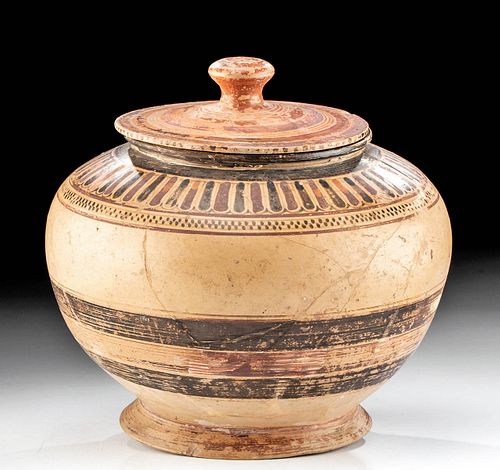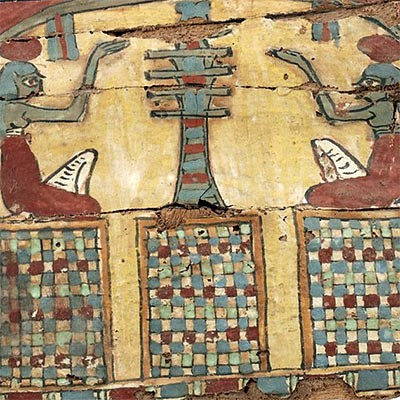Greek Corinthian Polychrome Lidded Pyxis
Lot 14
About Seller
Artemis Fine Arts
686 S Taylor Ave, Ste 106
Louisville, CO 80027
United States
Selling antiquities, ancient and ethnographic art online since 1993, Artemis Gallery specializes in Classical Antiquities (Egyptian, Greek, Roman, Near Eastern), Asian, Pre-Columbian, African / Tribal / Oceanographic art. Our extensive inventory includes pottery, stone, metal, wood, glass and textil...Read more
Categories
Estimate:
$1,300 - $2,000
Absentee vs Live bid
Two ways to bid:
- Leave a max absentee bid and the platform will bid on your behalf up to your maximum bid during the live auction.
- Bid live during the auction and your bids will be submitted real-time to the auctioneer.
Bid Increments
| Price | Bid Increment |
|---|---|
| $0 | $25 |
| $300 | $50 |
| $1,000 | $100 |
| $2,000 | $250 |
| $5,000 | $500 |
| $10,000 | $1,000 |
| $20,000 | $2,500 |
| $50,000 | $5,000 |
| $100,000 | $10,000 |
| $200,000 | $20,000 |
About Auction
By Artemis Fine Arts
Jul 30, 2020
Set Reminder
2020-07-30 10:00:00
2020-07-30 10:00:00
America/New_York
Bidsquare
Bidsquare : Ancient / Ethnographic From Around the World
https://www.bidsquare.com/auctions/artemis-gallery/ancient-ethnographic-from-around-the-world-5382
Ancient art from Egypt, Greece, Italy and the Near East, as well as Asian, Pre-Columbian, Native American, African / Tribal / Oceanic, Spanish Colonial, Russian Icons, Fine art, much more! All categories, all price ranges... all legally acquired and guaranteed to be as described or your money back. Artemis Fine Arts info@artemisgallery.com
Ancient art from Egypt, Greece, Italy and the Near East, as well as Asian, Pre-Columbian, Native American, African / Tribal / Oceanic, Spanish Colonial, Russian Icons, Fine art, much more! All categories, all price ranges... all legally acquired and guaranteed to be as described or your money back. Artemis Fine Arts info@artemisgallery.com
- Lot Description
Ancient Greece, Corinth, ca. late 6th to first half of the 5th century BCE. A beautiful example of a wheel-thrown pottery pyxis that perhaps held cosmetics, ointments, or trinkets. The vessel presents with an applied foot, a broad, apple-shaped body with a smooth shoulder, a squat rim with a slightly flared lip surrounding the deep interior cavity, and a discoid lid with a knob handle. The beige-slipped vessel bears wide decorative bands of black and red-brown pigment on the foot and lower body, with a slender band of black stippling enclosed within a pair of horizontal red stripes, and a register of repeating black-and-red tongues radiating around the rim. Rings of black and red paint further accentuate the rim, and the lid top displays several concentric orange-and-red rings. The name pyxis derived from Corinthian covered wooden boxes made from boxwood trees called 'puksos.' Size (w/ lid): 7.2" W x 6.75" H (18.3 cm x 17.1 cm)
For a stylistically similar example of the body, please see The Metropolitan Museum of Art, accession number 41.162.44.
For an example of a stemmed pyxis with nearly identical motifs around the shoulder, please see The Museum of Fine Arts, Houston, accession number 34.132.
Provenance: ex-Artemis Gallery; ex-private New Jersey, USA collection; ex-Helios Gallery, U.K., acquired in the 1990s; ex-William Froelich collection, New York, USA, acquired in the 1980s
All items legal to buy/sell under U.S. Statute covering cultural patrimony Code 2600, CHAPTER 14, and are guaranteed to be as described or your money back.
A Certificate of Authenticity will accompany all winning bids.
We ship worldwide and handle all shipping in-house for your convenience.
#152837Vessel and lid repaired from multiple large pieces, with small chips and light in-fill material in areas of loss, and resurfacing along new material and break lines. Lid may not be original to vessel body. Lid and body have abrasions and fading to original pigmentation, with areas of touch-up painting to some body decorations, and light encrustations. Great traces of original pigment and decorative motifs throughout.Condition
- Shipping Info
-
All shipping is handled in-house for your convenience. Your invoice from Artemis Gallery will include shipping calculation instructions. If in doubt, please inquire BEFORE bidding for estimated shipping costs for individual items.
-
- Buyer's Premium



 EUR
EUR CAD
CAD AUD
AUD GBP
GBP MXN
MXN HKD
HKD CNY
CNY MYR
MYR SEK
SEK SGD
SGD CHF
CHF THB
THB















